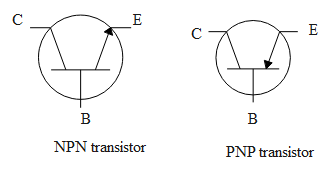
In a transistor, the base is
(A) a conductor of low resistance
(B) a conductor of high resistance
(C ) an insulator
(D) an extrinsic semiconductor
Answer
505.8k+ views
Hint: A transistor is an extrinsic semiconductor. That is, the emitter, collector and base is made of extrinsic semiconductor. The emitter and collector region of a transistor is heavily doped and the base of a transistor is lightly doped. Thus compared to emitter and collector base is made of thin layered semiconductor.
Complete answer:
A transistor is a semiconductor device. It usually has three terminals. That is, emitter, base and collector. It is a three terminal device which has two p-n junctions. These two p-n junctions are placed back to back in a single piece of semiconductor material. Mainly there are two types of transistors. They are bipolar junction transistor and field effect transistor. An npn transistor is formed by sandwiching p-type material between two n-type materials. Similarly, a pnp transistor is formed by sandwiching n-type material between two p-type materials. BJT is a three terminal device. They are emitter, base and collector.

Emitter region usually supplies charge carriers to other two regions. Usually, the emitter is heavily doped. In npn transistors, the emitter supplies free electrons to the junction. Collector is usually used to collect charge carriers. Collector is the largest part of a transistor rather than the emitter and base. The doping of the collector is intermediated between the emitter and base.
Hence, option (D) is correct.
Note:
For normal operations of a transistor the emitter-base junction is forward biased, so that the junction offers low resistance to the flow of current. The collector-base junction is reverse biased, so that the junction offers high resistance to the flow of current. The emitter and collector region of a transistor is heavily doped and the base of a transistor is lightly doped. Thus compared to emitter and collector base is made of thin layered semiconductor.
Complete answer:
A transistor is a semiconductor device. It usually has three terminals. That is, emitter, base and collector. It is a three terminal device which has two p-n junctions. These two p-n junctions are placed back to back in a single piece of semiconductor material. Mainly there are two types of transistors. They are bipolar junction transistor and field effect transistor. An npn transistor is formed by sandwiching p-type material between two n-type materials. Similarly, a pnp transistor is formed by sandwiching n-type material between two p-type materials. BJT is a three terminal device. They are emitter, base and collector.

Emitter region usually supplies charge carriers to other two regions. Usually, the emitter is heavily doped. In npn transistors, the emitter supplies free electrons to the junction. Collector is usually used to collect charge carriers. Collector is the largest part of a transistor rather than the emitter and base. The doping of the collector is intermediated between the emitter and base.
Hence, option (D) is correct.
Note:
For normal operations of a transistor the emitter-base junction is forward biased, so that the junction offers low resistance to the flow of current. The collector-base junction is reverse biased, so that the junction offers high resistance to the flow of current. The emitter and collector region of a transistor is heavily doped and the base of a transistor is lightly doped. Thus compared to emitter and collector base is made of thin layered semiconductor.
Recently Updated Pages
Master Class 12 Biology: Engaging Questions & Answers for Success

Master Class 12 Physics: Engaging Questions & Answers for Success

Master Class 12 Economics: Engaging Questions & Answers for Success

Master Class 12 Maths: Engaging Questions & Answers for Success

Master Class 11 Economics: Engaging Questions & Answers for Success

Master Class 11 Accountancy: Engaging Questions & Answers for Success

Trending doubts
Which are the Top 10 Largest Countries of the World?

Differentiate between homogeneous and heterogeneous class 12 chemistry CBSE

Why is the cell called the structural and functional class 12 biology CBSE

Sketch the electric field lines in case of an electric class 12 physics CBSE

State and explain Coulombs law in electrostatics class 12 physics CBSE

a Tabulate the differences in the characteristics of class 12 chemistry CBSE




